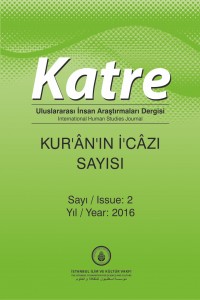Öz
Abstract
Miracle, which subjects Qur’an’s uniqueness in respect of its utterance and meaning
is factually been recognized in the time of revelation; but its theoretical and contextual
boundaries is been determined in the end of second or in the beginning of third century
of the hegira calendar. On the other hand, the relation between the surah and the verses of
the Qur’an which are related to miracles was founded as a discipline in the fourth century
of hegira calendar. This relation is seen as important angle of miracle by many classic
and modern Muslim scholars. In this study, the relation between surah and the verses of
the Qur’an which are related to miracles is aimed to be founded in accordance with Said
Nursi who is a modern Muslim scholar and emphasizes miracles in his works. This article,
which covers this subject in the case of Risale-i Nur, also allows for different perspectives
in this regard.
Kaynakça
- Mustafa Öztürk, Kur’ân Dili ve Retoriği, Kitâbiyât Yayınları, Ankara, 2002, 169.
Öz
Öz
Kur’ân’ın lafız ve mana itibariyle benzersizliğini konu edinen i’câz, olgusal olarak
nüzûl döneminde idrak edilmiş; ancak onun kuramsal ve mahiyet itibariyle sınırları, hicrî
ikinci asrın sonu ya da üçüncü asrın başlarında belirlenmiştir. Öte taraftan i’câzla bağlantılı
olan Kur’ân’ın ayet ve sureleri arasındaki ilişki, hicrî dördüncü asırda bir ilim olarak
ortaya konulmuştur. Bu ilişki, klasik ve modern dönem İslâm âlimlerinden birçok kişi
tarafından Kur’ân’ın önemli i’caz yönlerinden biri olarak görülmüştür. Bu çalışmada, modern
dönem İslam âlimlerinden biri olan ve eserlerinde i’câz meselesine sıkça vurgu yapan
Said Nursî’nin, Kur’ân’ın ayet ve sureleri arasındaki ilişkiyi hangi bağlamda ve nasıl bir
perspektifle ortaya koyduğunun tespit edilmesi hedeflenmektedir. Mevzu bahis meseleyi
Risale-i Nur örneğinde ele alan bu makalede, konuyla ilgili farklı yaklaşımlara da yer
verilecektir.
Abstract
Miracle, which subjects Qur’an’s uniqueness in respect of its utterance and meaning
is factually been recognized in the time of revelation; but its theoretical and contextual
boundaries is been determined in the end of second or in the beginning of third century
of the hegira calendar. On the other hand, the relation between the surah and the verses of
the Qur’an which are related to miracles was founded as a discipline in the fourth century
of hegira calendar. This relation is seen as important angle of miracle by many classic
and modern Muslim scholars. In this study, the relation between surah and the verses of
the Qur’an which are related to miracles is aimed to be founded in accordance with Said
Nursi who is a modern Muslim scholar and emphasizes miracles in his works. This article,
which covers this subject in the case of Risale-i Nur, also allows for different perspectives
in this regard.
Kaynakça
- Mustafa Öztürk, Kur’ân Dili ve Retoriği, Kitâbiyât Yayınları, Ankara, 2002, 169.
Ayrıntılar
| Birincil Dil | Türkçe |
|---|---|
| Bölüm | Hakemli Makaleler |
| Yazarlar | |
| Yayımlanma Tarihi | 6 Eylül 2016 |
| Gönderilme Tarihi | 23 Şubat 2017 |
| Yayımlandığı Sayı | Yıl 2016 Sayı: 2 |
Katre Uluslararası İnsan Araştırmaları Dergisi Creative Commons Atıf-Gayri Ticari 4.0 Uluslararası Lisansı ile lisanslanmıştır.
https://dergipark.org.tr/tr/pub/katre
E-mail: katre@iikv.org



